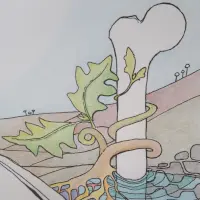We can just redefine value: producing something is valuable, providing services is. Telling stories is service, being kind is service, vibing with us is service.
Inclusive design of anything means that it can be used by disabled people wihtout special assitance. So an accessible public transport system would have things like level boarding, guidance for blind people, lifts and so forth. It does not mean everybody has to use public transport or that public transport stops at every door. In fact you generally have other modes of individual transport for the last mile. The key ones are walking and cycling. You can design for that as well, without too many problems.
However disabilities put disabled people at a disadvantage by definition. There are a lot of different ones and that means that irl you are always going to have situations, which require disabled people to be given help. So be mindfull of that and do not call a good plan bad, because it is not perfect. A walkable, cycleable city with great public transport, really would improve life for a lot of people. Including a lot of disabled ones. For example when you are blind, you can not operate a car, but you propably can walk to the next train station and use public transport with maybe a bit of help.
This seems like a more nuanced take on the subject than I’ve seen elsewhere, I’m hoping you won’t mind if I ask a bunch of questions I’ve had on this for a little while:
I realized, during some previous conversations on this subject, that out of all the private homes I’ve been inside in my life, I could only think of one that would meet all requirements I know of for accessibility. I’m trying to make art of better, more inclusive futures, but I suspect I have some default assumptions about building design that’ll run afoul of that. I’d really like to get a better sense of what people are looking for in inclusive design, what new ideas I should try to depict, and what’s okay to keep from our current way of doing things.
Stairs for example: government, commercial, and apartment buildings are all obviously already supposed to be accessible (though I’ve definitely lived in some old apartments that weren’t). But the way private houses are built around here, the foundation tends to add enough elevation to each structure that the door is several feet above the ground, and they use stairs on the outside. Even my blind grandmother climbs three steps to get into her house. The only place I can think of where that wasn’t the case was in Florida (ironic because it flooded). It was a condo that had been built on a slab foundation level with the sidewalk outside. Everywhere else I’ve been, there’s an elevation change. I understand the reasons for the height given our climate, but that’s an automatic exclusive feature, right? So when I depict private homes, should every house have a ramp or elevator up onto the porch? If I include stairs without showing an alternative, for example, in a picture of a rural homestead or similar, am I going to run afoul of these goals? What about inside?
On the scene I did of the parking garage converted into an apartment building, I made sure there were first floor apartments, and to clarify in the text and image that the original ramps between floors were intact (though I’m not sure the grade would be correct). But on the kitchen, I added a staircase to a rootcellar without thinking about it. Should we build with the expectation that even if the homeowner isn’t disabled, that they should plan for disabled guests and the guests should be able to go in the rootcellar? Nobody called me out on that one but it’s possible they didn’t notice the banister in the background of the scene.
Okay, other questions: what other accessibility features would you all like to see in a more inclusive community? I harped on stairs because they’re an obvious, visible one, but I know there are other things we could be doing.
And where does this all line up with reusing what’s here? I believe strongly in the importance of reuse, so I’m not likely to depict new construction as much as retrofitted/repurposed older buildings. I really can’t see a solarpunk future just bulldozing what’s here and starting over. My takes on solarpunk tend to be more post-postapocalyptic, focused on rebuilding better, rather than pure utopian; I don’t see much point in depicting ideal post-scarcity settings, I don’t think they’re actionable, or if we ever make it that far, we won’t need my pictures to help plan anything.




